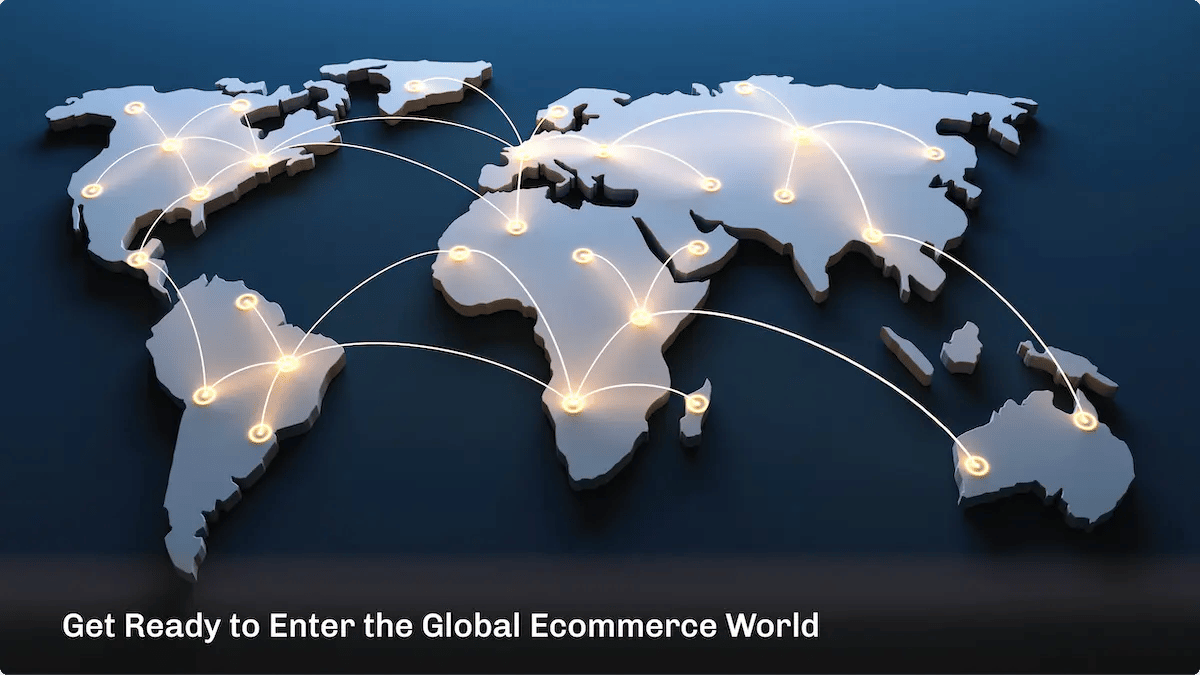There is no denying the prevalence of the Ecommerce industry in our world today. Online commerce has shaped not only the way the US does business but the way the world does business as well.
As more and more Ecommerce stores start to think bigger and start expanding into the world of international online retail, there has become a growing interest in the upcoming growth and analytics surrounding the Ecommerce industry as we enter 2023.
While the potential of expanding into international Ecommerce operations brings a great deal of excitement, it also comes with a lot of questions as well. The best way to get personal answers to these questions is to take a further look into the world of global Ecommerce.
Are you ready to see where the international Ecommerce industry is headed in 2023?
Global Ecommerce Industry |
What is Global Ecommerce?
Simply put, global Ecommerce involves the selling of products or services across different countries. This involves the selling of products or services from one market into another non-native market.
Before we dive into where the global Ecommerce industry is headed in 2023, it’s important to have an understanding of what global Ecommerce is and where it’s at right now. The industry is estimated to currently be worth more than $5.7 trillion and poised to only grow more in the coming years and according to Statista, this number will grow to $6.51 trillion by 2023.
Approximately two years ago, 17.8% of sales were made from online purchases, but this number is expected to grow to 23% by 2025 as global online sales continue to become more prevalent. That’s more than a 5% increase in just five years, with numbers only expecting to grow more.
Looking at a monster industry like that, you may be wondering where you can even begin as you try to break into an industry of this size.
Which Countries Are Seeing the Most Growth in the Ecommerce Industry?
The year 2020 changed so much in the Ecommerce industry around the globe. With literally the entire world shutting down, people started to become more inclined toward online shopping while brick-and-mortar stores had to close.
However, as the world moves forward from the aftermath of the pandemic, many countries are continuing to see huge jumps in their Ecommerce sales, making them great options for companies who want to venture into different markets.
It should come as no surprise that China continues to be the global leader when it comes to the Ecommerce market, however, there are other markets that, according to Statista, are seeing a giant increase as well, including:
- Latin America saw $104 billion in Ecommerce sales, which was a 22.4% increase from the year before.
- Russia is expected to experience enhanced growth. In 2022, the average revenue per online user in Russia was $375 USD, and it’s expected to reach an average of $434 per person by 2025.
- The European Ecommerce Union market is poised to continue with its fast climb in Ecommerce sales and is projected to have revenues of more than $1.2 trillion US dollars by 2025.
- India saw a 25.5% growth in sales in 2022 and is poised to see even more growth in 2023.
- The UK is expected to continuously increase by 42.88% by the year 2025.
However, it’s important not to forget about the domination of North America and its impressive share of the global market. With major players in the Ecommerce market including brands like Ebay, Etsy, Walmart, and Amazon, there’s no denying that North America plays a massive role in how people from across the world shop.
Why Should You Break Into the Global Ecommerce Industry?
No matter how big or small your Ecommerce business may be or what type of business you may be in—you should be at least considering the advantages of breaking into the international Ecommerce industry.
Here are some of the advantages of heading into the world of international Ecommerce:
- Lower barriers to entry
- Greater access to more customers
- Easier to find the right product-market fit
- Easier to build a strong international reputation
- Shorter business-to-business sales cycles
There are many businesses who may have thought going global with their sales only a few years ago wouldn’t be a possibility. However, there aren’t as many borders or barriers of entry as there once were. True global Ecommerce is a possibility now and will be well into 2023.
While established organizations and large enterprises have already been thinking globally when it comes to their Ecommerce operations, there is also a trend among small to medium businesses who are starting to “go global” as well.
For smaller Ecommerce brands who have yet to dip their toes in the waters of the global market, it’s important to have the right strategy for getting started in global interactions.
How Do Ecommerce Brands Dive Into the Global Market in 2023?
Truly understanding global Ecommerce isn’t just about looking at where it is today, but it's about looking at where it’s heading tomorrow as well. Over the last ten years, the Ecommerce market has evolved from giving brick-and-mortar locations an online presence to an entire thriving Ecommerce ecosystem.
Today, the global Ecommerce market involves multiple channel strategies, and it is completely reinventing the way that people today shop for virtually everything. As these changes continue to influence our world today, customers are looking for more and more convenience in virtually any and every way.
For some customers, this added convenience means more product customizations or easier checkout processes—but for many shoppers, it simply means access to more, including access to more stores around the world. There is a growing expectation for more businesses, even smaller ones, to offer their products or services worldwide.
Focusing on the Impact of Smartphone Technology
Chances are, you’re already seeing the expansion of some online retailers who are presenting their online stores in different languages and with different currencies so that they can better appeal to more international shoppers.
The implementation of 4G and 5G technology for connectivity is expected to help with this expansion and has made it easier than ever to grow, thanks to uninterrupted and seamless communication channels.
Plus, as smartphones continue to be even more prevalent across the world, more and more shoppers are finding it easier to buy what they want, from where they want, and whenever they want, all with the press of a button. This growing prevalence of smartphones is only expected to project the small business market growth further over the next few years.
In 2022, it was estimated that mobile Ecommerce accounted for approximately 65% of all worldwide Ecommerce retail transactions and that number is only expected to grow.
Here are some mobile Ecommerce trends that brands should be on the lookout for in 2023:
- Personalized experiences and suggestions based on location, purchase history, and browsing behavior.
- Dynamic pricing based on location and supply and demand.
- Mobile-exclusive deals to encourage mobile purchases
No matter what market, country, or industry an Ecommerce business may be in, they need to take mobile technology and its impact on pricing strategies as they look into 2023.
Embracing New Ways to Pay
As both mobile Ecommerce shopping and global shopping become prevalent, brands need to pay close attention to the use of digital wallets and various ways for international shoppers to pay safely.
With the recent expansion of Apple Pay, Google Pay, Square, and PayPal over the past few years, these payment methods should be taken into account, including how they can impact your Ecommerce pricing.
Here’s how accepting additional payment methods can impact your pricing in 2023:
- More transaction fees may increase the overall cost of a purchase.
- Higher conversion rates. For example, if you are accepting both USD and EUR, there will be exchange rates to take into account when setting prices to make sure that it’s always making a profit.
- New payment methods from competitors may bring extra competition among shoppers.
In 2023, Ecommerce brands are going to need to seriously look into what payment methods they want to accept, how to accept different currencies, and consider options like “buy now pay later” to stay relevant in terms of how customers pay their favorite Ecommerce brands.
Committing to Customer Service
A commitment to customer service is one of the best ways to expand into more global offerings. Good customer service is essential no matter what part of the world you are working from. In 2023, Ecommerce brands should look into offering multiple forms of customer service aside from just a phone number.
Here are some of the cornerstones of customer service that global Ecommerce brands should focus on:
- Access to different types of customer service channels. This includes email, texting, and live chat customer service capabilities.
- Offering customer service in a variety of languages and covering a variety of time zones.
- Using social media as a way to interact with customers across the globe and create more of a relationship with customers.
No matter how small your Ecommerce brand is now, or how big it’s going to be, quality customer service is a must. So many shoppers will completely abandon a brand if they’ve had a bad customer service experience and if you want to compete with global competition, then you need to make customer service a priority.
Focusing on Global Shipping and Logistics
One of the biggest hurdles that global Ecommerce brands will face in 2023 and beyond all has to do with shipping and logistics. In fact, most shoppers who purchase products from an international seller worry primarily about how long it will take to get their items (and how expensive that shipping will be).
The best way to make international shipping a reality is to take the time to remove as many potential issues as possible. According to Statista, the average order value of an international sale for a brand in the US is 17% higher than the average domestic sale. This is why you need to create an international shipping strategy.
Here are tips on how to get started with global shipping and logistics in 2023:
- Start close. Before diving into worldwide shipping, start by offering international shipping to one close location. For example, if you live in the south, try Mexico, or if you operate out of New York, offer shipping to Canada.
- Use traffic analytics to see what customers from which markets are already shopping at your online stores so that you can gauge interest on where you may want to.
Doing this will help you slowly dip your toes into the world of international shipping so that you can see first-hand what international expansion can do for your Ecommerce brand as you start to grow on a worldwide basis in 2023 and into the future.
Conclusion
The year 2023 is going to see even more changes in the global Ecommerce market. The only question that you should have about what is going on and what will happen with the future of Ecommerce—is how you can make sure you’re jumping in head-first.
 You've made it this far and you've learned so much. Congratulations!
You've made it this far and you've learned so much. Congratulations!
If you're looking to learn more about marketing or Ecommerce in general, feel free to reach out to us at: solutions@undigital.com
You May Also Like
These Related Stories

Ecommerce Influencer Marketing

The Top Ecommerce Marketing Courses


